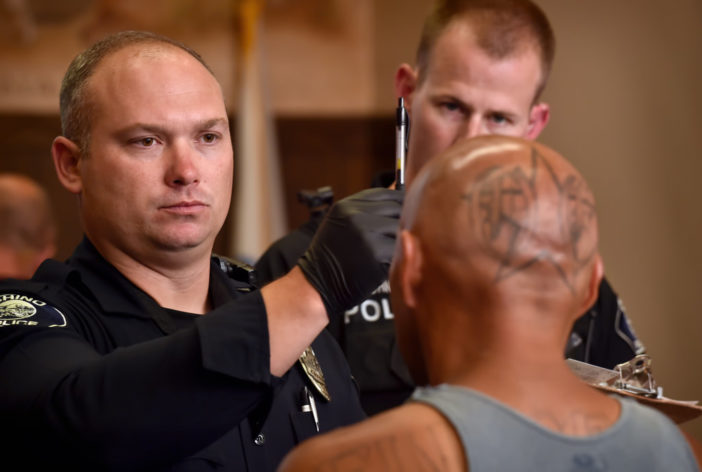The first question is, “What have you eaten today?”
It’s already a pivotal moment in the 30-minute to 45-minute process of evaluating a person for possible drug intoxication.
The question can help determine if a person’s impaired state is actually due to a medical condition instead of a drug. It’s a question that can save lives.
Various other questions are asked and physical tests given by the officers gathered in a room at the Fullerton Police Department on April 28 as part of their training to become Drug Recognition Experts – or DREs.
The officers, from the Santa Ana, Pasadena and Chino police departments as well as the Orange County Sheriff’s Department, are in the third stage of their training and already have endured over 100 hours of training to be here.
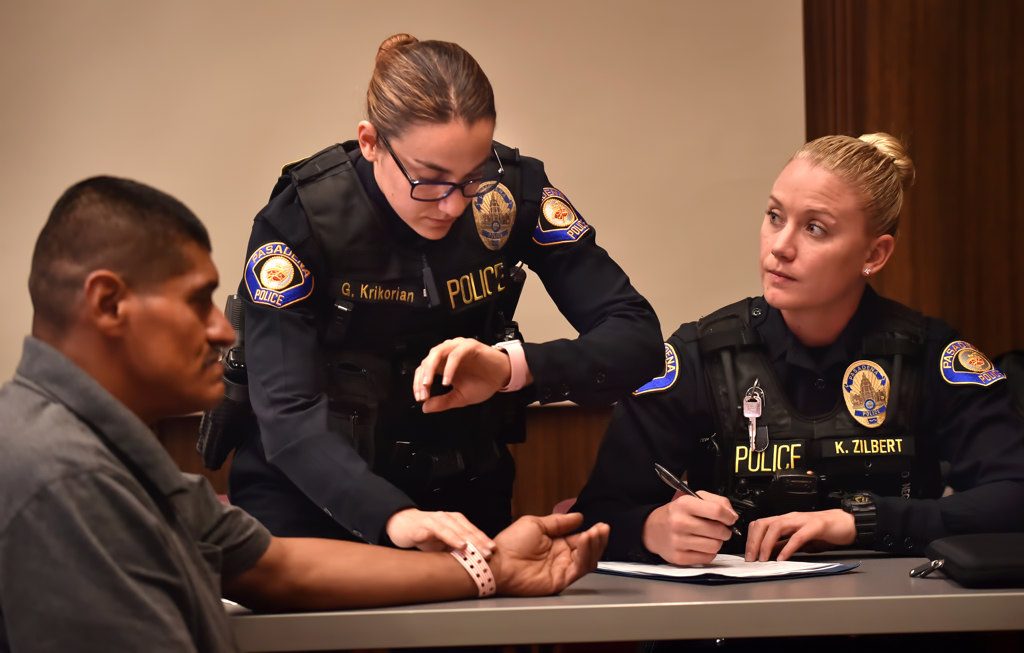
Pasadena PD Officers Gyaneh Krikorian and Kourtney Zilbert, right, check the pulse of a person suspected to be under the influence during an officer drug detection training session at the Fullerton PD.
Photo by Steven Georges/Behind the Badge OC
“The program is not for everybody. There are no softball answers here. They have to go and do the work,” says California Highway Patrol’s Glen Glaser, state coordinator for the DRE program. “The importance of the program is that people are being trained to objectively determine who is impaired. The last thing we want to do is arrest innocent people.”
The training is extensive because of the growing need to get it right. DUI drug arrests now exceed those for DUI alcohol in the United States. And since the passing of Prop. 64, which decriminalized marijuana last fall, DUI drug arrests have increased 40 percent.
Drug recognition training began in California in 1979 after a decade of rigorous research proved that non-medical personnel could – with the proper training – deduce not only if a person was under the influence of drugs, but also if that drug was a depressant, stimulant, cannabis, hallucinogenic, inhalant, dissociative anesthetic or opiate.

Chino PD Officer Matt Johnson puts a suspect through a series of tests during a training session at the Fullerton PD.
Photo by Steven Georges/Behind the Badge OC
The program, funded by the California Office of Traffic Safety and administered by the California Highway Patrol, has overcome several hurdles since then to become an ever-more accepted tool for law enforcement.
In fact, a sign of its success is that only the possibility of procedural oversight by DREs is tested in the courtroom and not the merits of drug recognition itself. And defense lawyers do try.
“They take a lot of heat on the stand,” says Fullerton PD traffic officer and veteran DRE, Eric Franke. “And for no extra pay. It’s just for the satisfaction of doing a good job.”
The training in Southern California takes place at the Fullerton PD, where as many as 3,000 of the total 27,000 officers in the United States have been trained. A few have come from other countries for training as well, including Canada, the United Kingdom, Australia, Guam and South Africa.
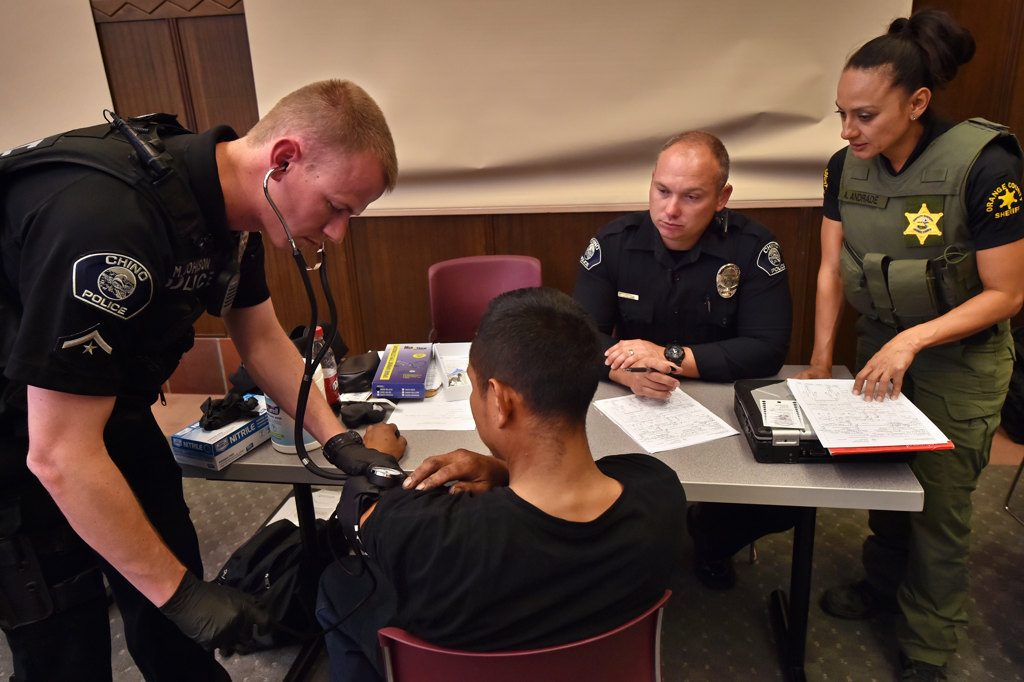
Chino PD Officer Matt Johnson takes a pulse of a suspect as Chino Officer Kevin Kline and Orange County Sheriff’s Department Deputy Angela Andrade take notes during a training evaluation at the Fullerton PD.
Photo by Steven Georges/Behind the Badge OC
More than 1,700 officers currently are certified DREs in California. More than 300 of those are in Orange County. And California also has more officers trained as DREs than in several other states combined.
The high standards of the program don’t stop when all this training is done. Each DRE must pass a recertification course every two years, due in part to the ever-evolving drug landscape.
The evaluations given to someone who appears to be under the influence include multiple questions, checking the person’s pulse at the beginning, middle and near the end of the evaluation, blood pressure, simple physical coordination tests similar to those given for drunken driving and also a blood test taken by a blood technician.
“All of this is done to give [those tested]the best chance to perform,” Franke says.
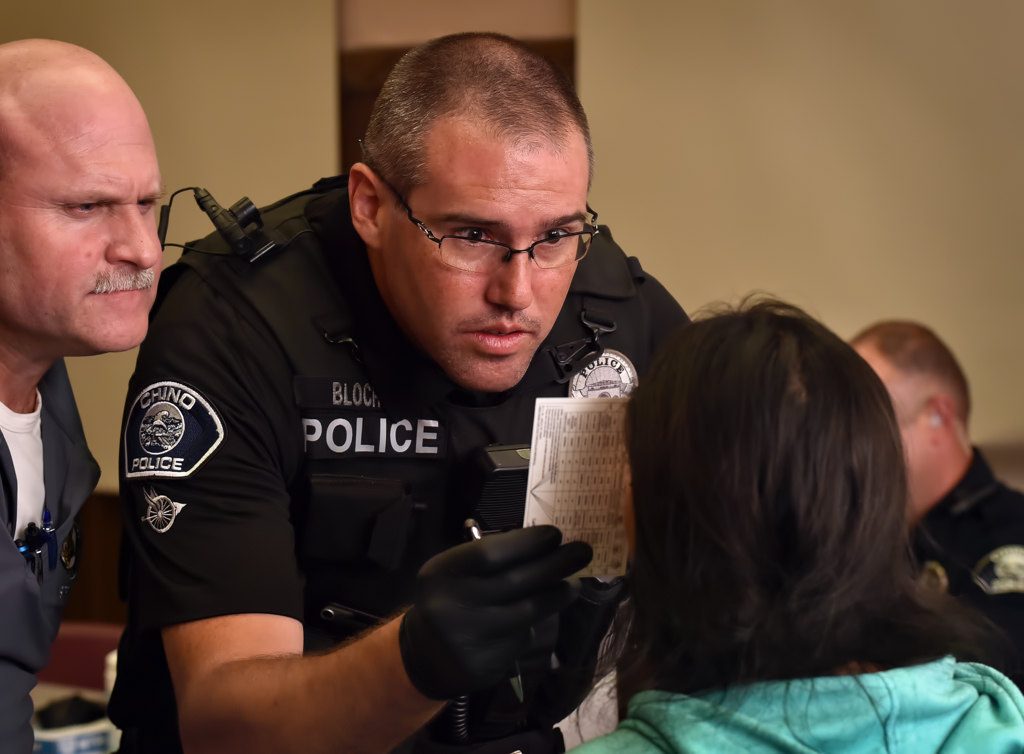
Chino PD Officer Matt Bloch checks the pupils of a suspect with a size chart during a drug recognition evaluation training session at the Fullerton PD.
Photo by Steven Georges/Behind the Badge OC
Inside the training hall, a 20-something man taken into custody just a few miles away is having his own struggles. He tells one of the DRE trainees he’s only had about three hours sleep. He can walk a straight line, mostly, but other physical coordination seems difficult. His pupils open and close over and over when a flashlight is shined in them, or what is referred to as pupil unrest.
He admits to using meth earlier in the day, but a blood sample taken by a blood technician (the 12th and final step) will still have to confirm what the officer has already concluded.
It’s worth it – the Office of Traffic Safety and the National Highway Traffic Safety Administration consider Orange County the gold standard of DUI drug prosecutions.
The DRE trainee does well on her evaluation. The young man goes to a holding cell. Law enforcement’s battle against the ravages of drug use goes on.
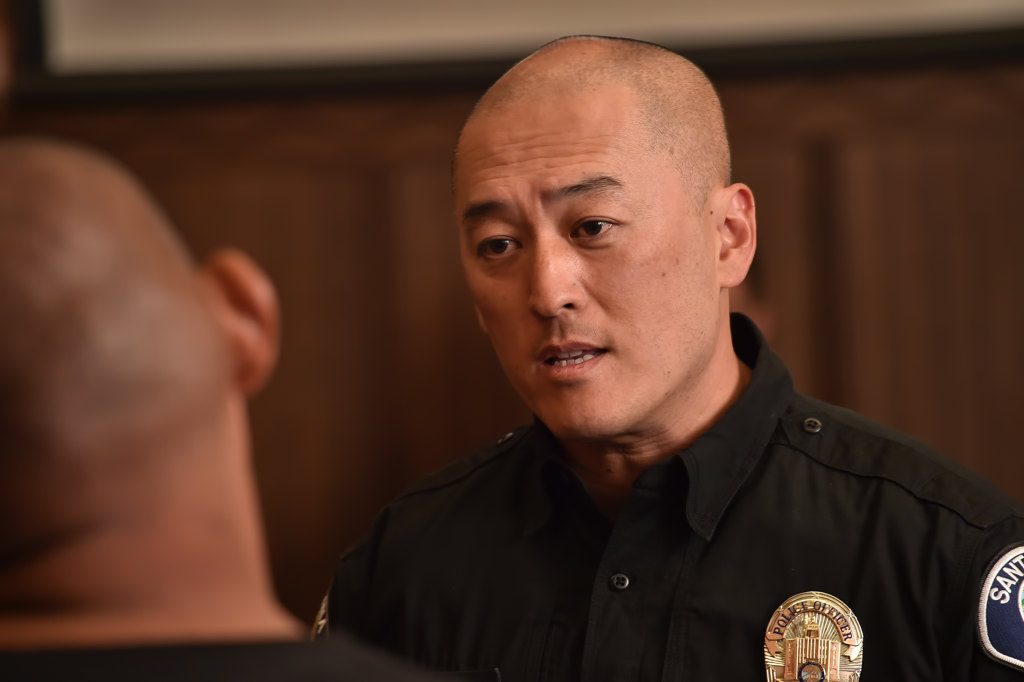
Santa Ana PD Officer Camillo Kim interviews a suspect during a drug recognition evaluation at the Fullerton PD.
Photo by Steven Georges/Behind the Badge OC
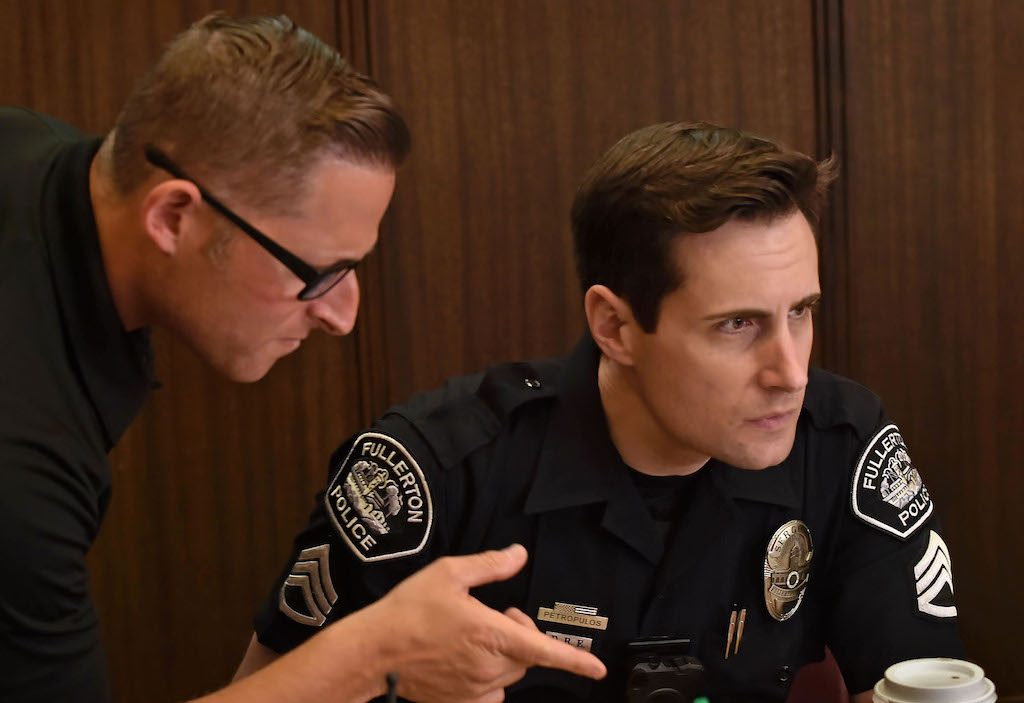
Fullerton PD Sgt. Jon Radus, left, with Fullerton PD Sgt. Tim Petropulos, discuss the results of an evaluation. They run the FPD’s DRE program along with Officer Eric Franke.
Photo by Steven Georges/Behind the Badge OC
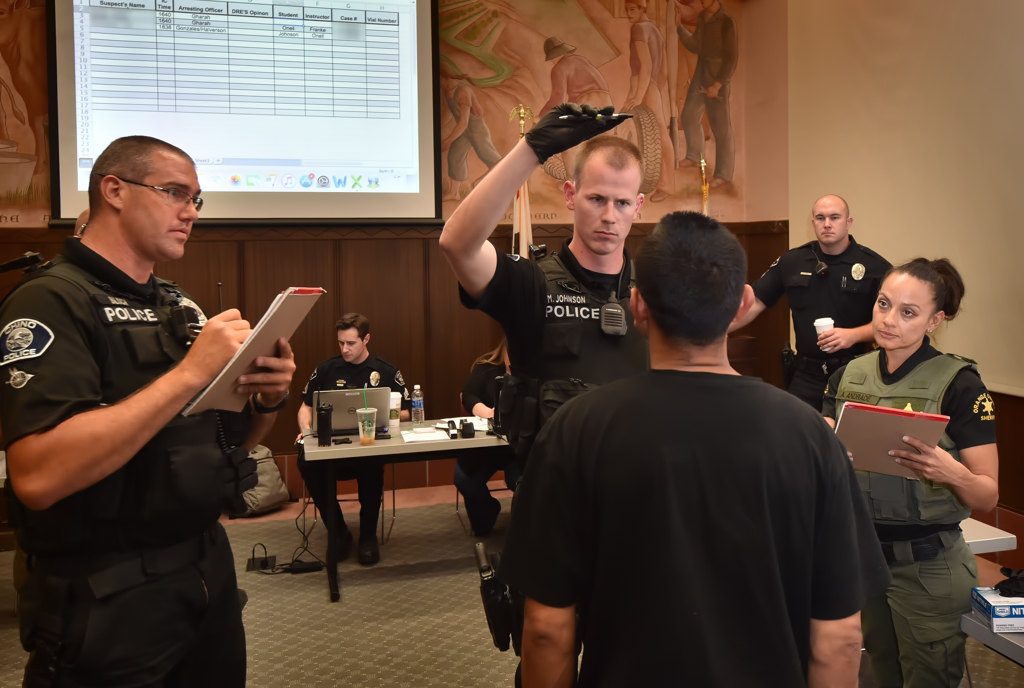
Chino PD Officers Matt Bloch, left, and Matt Johnson, with OCSD Deputy Angela Andrade, right, conduct an evaluation during a training session at the Fullerton PD.
Photo by Steven Georges/Behind the Badge OC
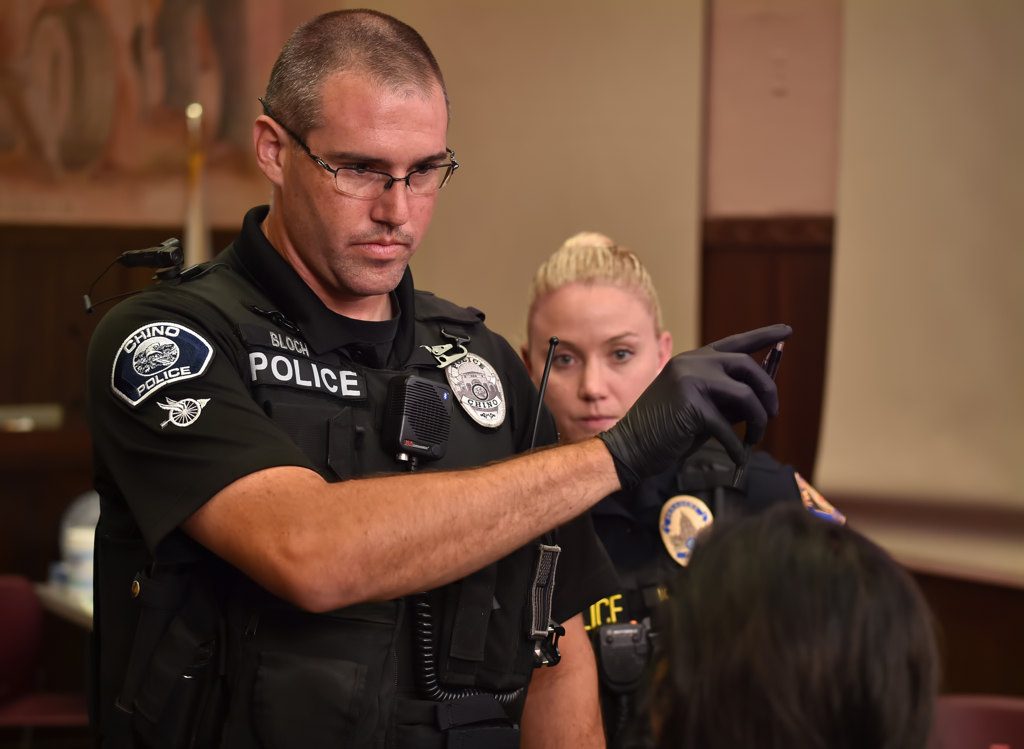
Chino PD Officer Matt Bloch tests the response of a suspect’s eyes during a training evaluation as Pasadena PD Officer Kourtney Zilbert takes notes.
Photo by Steven Georges/Behind the Badge OC
 Behind the Badge
Behind the Badge
